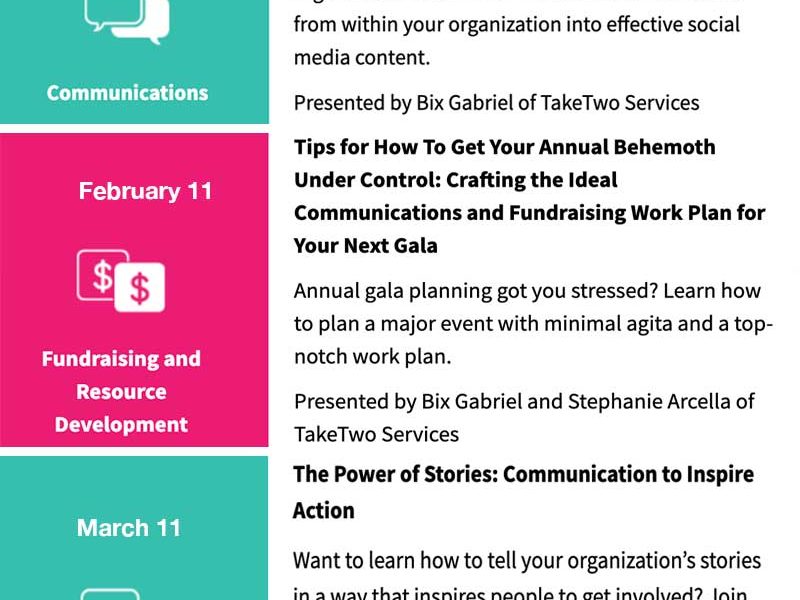
5 Steps to a Nonprofit Social Media Strategy that Earns Support
You ever have that moment when your social media feed is one long list of “give, give, give” requests? And you feel like Stanley does?  Chances are, your constituents feel this way, too.
Chances are, your constituents feel this way, too.
A recent study from the Case Foundation has found that 74% of nonprofits are making this mistake: making too many asks for support without showing why and how your organization is making an impact. Ticket sales and financial gifts are certainly important, but you won’t get far on social media if you don’t spend time building the case for why your organization deserves support.
Here are five steps to help you create social media content your audience will love – and improve the likelihood that they’ll become supporters.
1. Start with your mission statement.
The most important part of your social media strategy should be using social channels to showcase how your organization achieves its mission and why your work is important to the community. Use social channels to highlight your organization’s achievements, educate your audience on your work, and interact with those who have questions or comments. Show your outcomes and share your insights about the need for your services, and audiences will identify you as an authority in your niche – and a trustworthy recipient of their support.
Not sure how to make your mission a conversation on social media? Take a look at a few examples:
The American Red Cross
- Mission: The American Red Cross prevents and alleviates human suffering in the face of emergencies by mobilizing the power of volunteers and the generosity of donors.
- Facebook post: In March, 8-year-old Trinity Seymour woke to the sound of a blaring smoke alarm. Thanks to a recent school lesson on fire safety by Red Cross volunteer, Tim Reichel, Trinity knew exactly what to do to get herself and her young sister out of harm’s way http://rdcrss.org/trinity
UNICEF
- Mission: UNICEF is mandated by the United Nations General Assembly to advocate for the protection of children’s rights, to help meet their basic needs and to expand their opportunities to reach their full potential. (See more from UNICEF’s full mission statement)
- Tweet: “I dream about going back to school & not working anymore” Yasmeen, 14. #childrenofsyria #notochildlabour http://uni.cf/1dBXGtN
Oxfam
- Mission: To create lasting solutions to poverty, hunger, and social injustice.
- LinkedIn update: How is our understanding of development changing? This short paper by Duncan Green summarizes trends in international development and key questions for international NGOs http://bit.ly/1B4Qi5e
2. Review your existing analytics.
If you’re already using Facebook, Twitter, LinkedIn, or any other social channel, take a peek at your analytics data. Before you jump to examine details on post format type or day of the week, start by looking at the content of your posts and ask:
- What were the themes of the most engaging posts (those that earned the most clicks)?
- Which post topics earned the most reach, shares, and likes?
- What was different about the posts that failed to reach audiences?
Identifying the subjects your audience cares about most is a crucial step in planning social content that will earn support for your mission. Similarly, take note of the posts that underperformed and think about how they could be improved by making them more relevant to your mission, or approaching them again from a different angle.
3. Use your keywords to share related content (and save time).
While you’re looking at analytics, make note of the keywords in your best posts (and note that they may be different on each social channel). You can use these words in two ways:
- First: Use a site like Buzzsumo.com or Topsy.com to find relevant articles and social influencers who are tweeting about the topic. Sharing popular articles and retweeting from significant sources is a great way to grow your social presence – and save time if you don’t have your own new content ready to post.
- Second: Use the keywords again and experiment with variations while planning your next posts. Running into writer’s block? You may find the free Google AdWords Keyword Planner helpful for identifying more related words, but keep in mind that this tool is designed for search engines rather than social media. (Bonus: Apply for a Google Ads grant and put these words to work for you in search engines, too!)
4. Get visual.
Now that you’ve found the topics and keywords that will resonate with your audience, it’s time to add some images. Last year, eMarketer reported that posts with photos accounted for 87% of all posts shared on Facebook. With the rise of image-based social channels like Instagram and Tumblr, it’s easy to see that the trend favoring visuals is permeating social media.
But any old photo won’t do – low quality, irrelevant images will cause your social channels to lose followers rather than engage them. Be thoughtful and discriminating in selecting images for your posts, and strive to use high-quality visuals that achieve at least two of these criteria:
- Relate to your mission
- Stir an emotional response
- Show your team in action
- Highlight the beneficiaries of your work
- Provide a short fact or statistic
- Include a quote
5. Choose your words wisely.
There’s no shortage of research on the ideal length for online content. Hubspot released its own research on social media post length in April of this year, and listed 15 guidelines for character count, word count, and minute count on different channels. According to their study, Facebook posts should be even shorter than Twitter messages in order to earn the most engagement.
The bottom line? The shorter your posts, the better. Focus on whittling your message to be as concise as possible, and you’ll increase your social media impact. Here are some tips for cutting your word count:
- Eliminate articles like a, an, that, the, and which whenever possible.
- Cut out unnecessary adjectives.
- If you’re sharing a news story, use a short quote from the story as your post text.
- Share a single, striking fact from a story or paper (with a link to the original article, or a link to your campaign to make a difference for the issue).
Your social media accounts shouldn’t be an endless stream of calls-to-action for giving money. Instead, earn the love of your followers by creating an online presence that shows the impact of your work and how donor support makes it happen. Again, and again.
Kelsey Johnson is a 10-year practitioner of nonprofit communications and social media. When she’s not crafting compelling messages, she can be found exploring Florida’s beaches, woods, and the occasional brewery.





